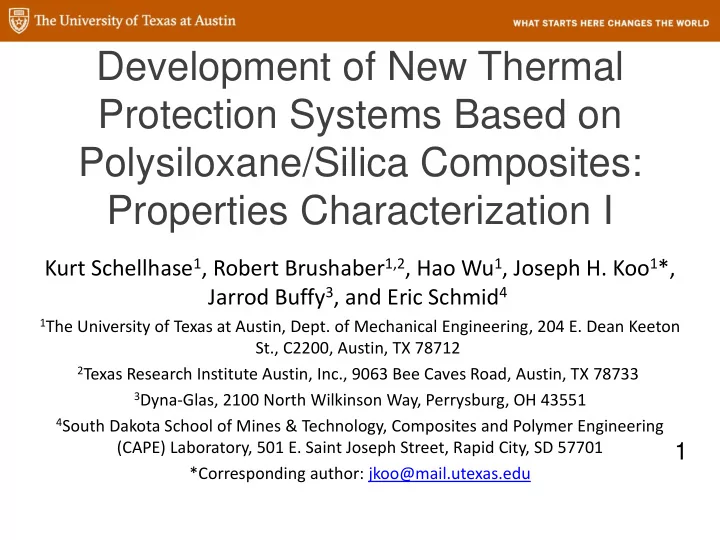

Development of New Thermal Protection Systems Based on Polysiloxane/Silica Composites: Properties Characterization I Kurt Schellhase 1 , Robert Brushaber 1,2 , Hao Wu 1 , Joseph H. Koo 1 *, Jarrod Buffy 3 , and Eric Schmid 4 1 The University of Texas at Austin, Dept. of Mechanical Engineering, 204 E. Dean Keeton St., C2200, Austin, TX 78712 2 Texas Research Institute Austin, Inc., 9063 Bee Caves Road, Austin, TX 78733 3 Dyna-Glas, 2100 North Wilkinson Way, Perrysburg, OH 43551 4 South Dakota School of Mines & Technology, Composites and Polymer Engineering (CAPE) Laboratory, 501 E. Saint Joseph Street, Rapid City, SD 57701 1 *Corresponding author: jkoo@mail.utexas.edu
Today’s Presentation • Background and Motivation • Material Systems • Characterization Methods • Results • Conclusion • Future Work 2
Background • Want to investigate new ablative material systems • Need for materials which can withstand harsher environments o Rocket Motors o TPS Materials for Re-entry Vehicle o Nose Cones – Atmospheric Probes o Vertical Launching Systems o Fire Prevention – Trains, Submarines, etc. 3
Ablative Materials • Resist thermochemical erosion caused by harsh environment • Formation of the protective char layer • Different mechanisms for different materials, no one size fits all ablative • Current SOTA resins: SC-1008, PT-15 4
SC-1008 • MIL-standard phenolic resole resin manufactured by Hexion • Typically carbon or silica fiber reinforcement • Foamed versions of phenolic used for low density ablators • Lots of data collected • Diverse applications, from TPS materials to rocket motor materials • Relatively cheap 5
PT-15 • Low viscosity cyanate ester (CE) resin manufactured by Lonza • Typically glass reinforcement • Different manufacturer, but CE/3D-quartz used as part of Orion heat shield/compression pad • More expensive 6
DT-1116 • Inorganic matrix, utilizing a mixture of polysiloxane chemistries manufactured Dyna-Glas Technologies LLC o Low thermal transfer o Excellent chemical resistance o Excellent thermal stability o Low heat release rate and heat release capacity o Low viscosity and cure temperatures • Will be examining two proprietary formulations – DT1116-1 and DT-1116-2 7
Material Characterization • Thermogravimetric Analysis • Thermal Stability & Char Yield • Microscale Combustion Calorimeter • Heat Release Rate and Capacity • Kinetic Parameters Modeling • Activation Energy 8
Char Yield Study 1. Dry the TGA sample 150C for 30min 2. Consistent sample size – 20mg 3. TGA heating rate of 20 C/min in nitrogen. 4. Char yield is defined as the %mass remaining at 1,000 C. 9 Developed based on a NASA report on PICA
Char Yield Study Char yield results for SC-1008, PT-15, DT1116-1, and DT1116-2 . 10
Char Yield Study dTGA for SC-1008, PT-15, DT1116-1, and DT1116-2 . 11
12 SC-1008 phenolic at heating rates of 5, 10, 20, and 40ºC/min
13 PT-15 cynate ester at heating rates of 5, 10, 20, and 40ºC/min
14 DT-1116-1 polysiloxane at heating rates of 5, 10, 20, and 40ºC/min
15 DT-1116-2 polysiloxane at heating rates of 5, 10, 20, and 40ºC/min
Decomposition temperature (T d ) of 10% mass loss temperature Weight % at 1,000ºC 16
Kinetic Parameters • The rate of thermal decomposition of polymers can be modeled by the kinetic rate equation • Need to have the correct kinetic parameters in order to have a accurate model • Used the isoconversion method to solve for the kinetic parameters 17
Kinetic parameters • Due to the multiple stage degradation and the high residual mass of the polysiloxane resins, the activation energy could not be accurately determined. • Model we are using works well with the single stage, 1 st order decomposition • Good model for some resins, but gives nonsensical activation energy values for DT- 1116 18
Flammability Properties • Microscale Combustion Calorimeter • Lab scale for small sizes • Screening tool • Good alternative to a cone calorimeter 19
Flammability Properties Typical heat release curves for the four resin systems 20
Flammability Properties Comparison of the Heat Release Capacities for the four resin systems 21
Conclusion • DT-1116-1 exhibited the best results with 87% char yield. An increase of ~54% compared to phenolic and cyanate ester resins. • DT-1116 had a HRC of 36 J/g-K. SC-1008 phenolic’s HRC was 48% higher at 53.31 J/g-K and PT-15 cyanate ester’s HRC was 443% higher at 159.33 J/g -K • Activation energy could not be accurately determined with the current models. A better model is needed. 22
Future Work • Dispersion of nanosilica into the resin, and additional characterization • Incorporation of silica fabric into the polysiloxane resin • Ablation testing using Oxygen-Acetylene Test Bed (OTB) and Inductively Coupled Plasma (ICP) torch • Mechanical properties 23
Questions?
Recommend
More recommend